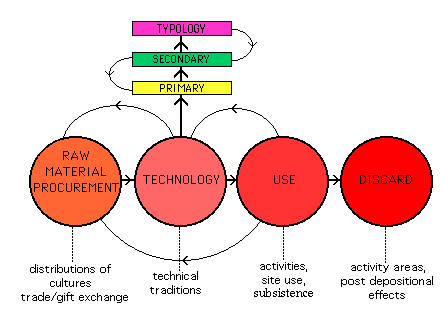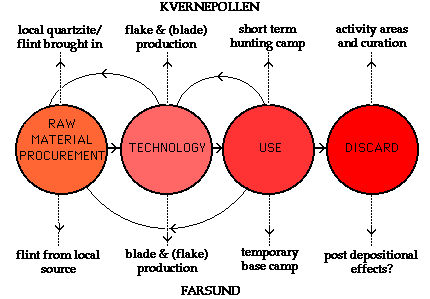
Figure 19: chaîne opératoire
The 'chaîne opératoire' approach provides a more complete picture of differences and similarities among human groups, rather than concentrating on single elements. With these sites, typological analysis results in a very small data base, technology shows no significant difference, and spatial analysis is difficult to compare because of the lack of patterns at Farsund. However, by combining all these elements within the framework of the operational sequence a greater understanding of the cultural differences can be sought.
Figure 19 summarizes the 'chaîne opératoire' approach. The four basic links are raw material procurement, technology (separated into primary and secondary reduction and typology), use and discard.

Figure 19: chaîne opératoire
However the sequence includes feed-back loops in that, for example, the intended use of tools will affect the choice of technology and raw material. If the intent was to make projectile points for hunting this could influence the choice of technology. For example, tanged A points (see Helskog et al. 1976, 26), are made on blades, so that blade technology would have been chosen to produce the suitable blanks. Also function need not be limited to utilitarian use. If the intention was to make a flint copy of a bronze dagger for a status or ritual function, the procurement of raw material might be by trade, in order to obtain large pieces of good quality flint with which to make such a dagger. Thus the intended function of the tool can influence technology and the method of raw material procurement.
The dotted lines in Figure 19 indicate the kind of interpretations that can be made from the various elements of the operational sequence. Figure 20 indicates and compares the interpretations from Kvernepollen and Farsund.

Figure 20:chaîne opératoire (Kvernepollen and Farsund compared)
These differences may reflect varying social structures and subsistence strategies employed during different periods. If one assumes a higher population in the Bronze Age then a pattern emerges of larger base sites from which small groups (or individuals) go out on hunting/fishing expeditions, as opposed to small family groups moving around together. These different strategies are chosen as the preferred means of exploiting similar environmental resources, rather than being adaptations to different environments. Basing ethnic or chronological divisions on typology and/or technology alone is a crude device that ignores much of the evidence of choice that reflects the social structure of human groups. Archaeological sites are the product of dynamic interaction between individuals within the social group, rather than static structures to be simply classified by typological lists or by measurement of debitage. This dynamic interaction can be studied with the chaîne opératoire approach which allows for a greater understanding of the complex human behaviour that lies behind the archaeological data.
The analysis presented in this paper is the product of the author's own research and does not necessarily agree with the excavators of the sites. The methods used for the lithic analysis are explained fully in Grace 1989 and Grace 1993.
©
Internet Archaeology
Last updated: Thu Mar 20 1997